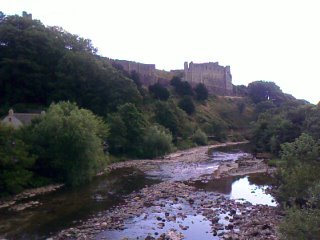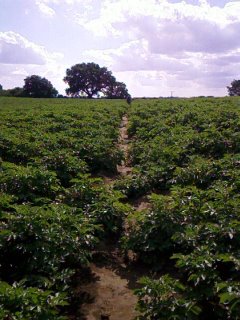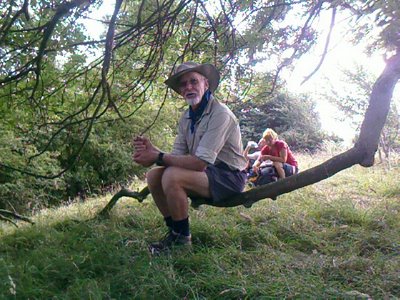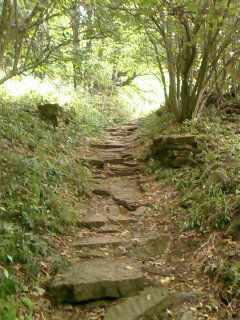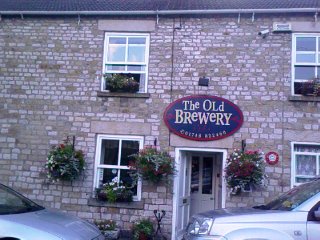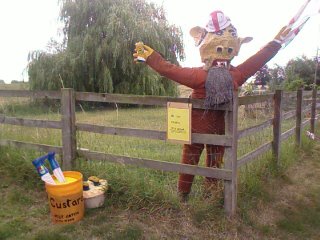 Off at a little past eight-thirty this morning from The Old School House, fortified with a famously huge English breakfast from Frank and Doreen. I travel with John and Elaine today, our last day on the same schedule.
Off at a little past eight-thirty this morning from The Old School House, fortified with a famously huge English breakfast from Frank and Doreen. I travel with John and Elaine today, our last day on the same schedule.After an encounter with a child-eating troll (one of many from a recent scarecrow competition), fields and some road-walking face us most of the way. I have left my trekking poles for the Sherpa folks to take to Osmotherley and am glad for the reprieve from hauling them around. I expect I’ll need them the next two days, though, as I head into another strand of fells to ridge-walk.

 We are at one of the many dairy farms on the route when I stop to tighten my bootlaces and John and Elaine walk on ahead. I see a milk tanker around the bend and, sure enough, I catch up to find my very outgoing friends talking with the crew—Diane and a coworker who are shunting milk from a 15700-litre tank to a 27000-litre tank for delivery to Osmotherley. A just-born calf is in a field nearby, bright white and black from mom’s cleaning, still too weak to stand.
We are at one of the many dairy farms on the route when I stop to tighten my bootlaces and John and Elaine walk on ahead. I see a milk tanker around the bend and, sure enough, I catch up to find my very outgoing friends talking with the crew—Diane and a coworker who are shunting milk from a 15700-litre tank to a 27000-litre tank for delivery to Osmotherley. A just-born calf is in a field nearby, bright white and black from mom’s cleaning, still too weak to stand.John and Elaine later tell me that Diane had offered us all a lift to Osmotherley, but they had declined.
“Why’d you do that?” I say only half-jokingly. I would have turned it down, too, but the dream of a ride is tempting. Dang.









 It’s another easy walking day—all flat until the last two miles through Cleveland Forest, which feels and looks like it’s been lifted right from the foothills of Mt Rainier, only with a wide gravel truck track instead of foot trail. The weather stays with us all day, windy, alternately warmish/coolish, with gray clouds rolling in by the afternoon. We pass over train tracks and rickety bridges, and by new construction, old ruins, and a beautiful private farm/garden at Ingleby Cross.
It’s another easy walking day—all flat until the last two miles through Cleveland Forest, which feels and looks like it’s been lifted right from the foothills of Mt Rainier, only with a wide gravel truck track instead of foot trail. The weather stays with us all day, windy, alternately warmish/coolish, with gray clouds rolling in by the afternoon. We pass over train tracks and rickety bridges, and by new construction, old ruins, and a beautiful private farm/garden at Ingleby Cross. We have a lunch break in the woods at Cleveland Forest, where John sets up their camp stove to make their usual batch of Australian billy tea. He shows me how to swing the covered kettle like a man pitching a baseball, ostensibly to swirl the tea in the water before steeping and pouring. Given that centrifugal force is at work, I more wonder whether it’s really just a way to squeeze the teabag without touching it.
We have a lunch break in the woods at Cleveland Forest, where John sets up their camp stove to make their usual batch of Australian billy tea. He shows me how to swing the covered kettle like a man pitching a baseball, ostensibly to swirl the tea in the water before steeping and pouring. Given that centrifugal force is at work, I more wonder whether it’s really just a way to squeeze the teabag without touching it.
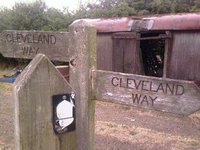 A spate of rain comes as we leave our protected spot for lunch, but not enough to do more than wet the road. We part company shortly after, so John and Elaine can get a couple more miles in tonight on the trail and cut their longer day short tomorrow. We’re to meet for dinner in Osmotherley, which is a mile off the track and on the famous Cleveland Way trail that the C2C is just about to intersect with for a while.
A spate of rain comes as we leave our protected spot for lunch, but not enough to do more than wet the road. We part company shortly after, so John and Elaine can get a couple more miles in tonight on the trail and cut their longer day short tomorrow. We’re to meet for dinner in Osmotherley, which is a mile off the track and on the famous Cleveland Way trail that the C2C is just about to intersect with for a while.
 I get to Osmotherley around 2:30 and walk the extra mile beyond town to get to my B&B. It’s clearly too early for check-in, for the proprietress isn’t home, so I head back to the village to kill some time. I buy the last two OS maps for the walk, poke into a few stores, and take a pot-for-one earl grey tea and toasted tea bread at a coffee shop.
I get to Osmotherley around 2:30 and walk the extra mile beyond town to get to my B&B. It’s clearly too early for check-in, for the proprietress isn’t home, so I head back to the village to kill some time. I buy the last two OS maps for the walk, poke into a few stores, and take a pot-for-one earl grey tea and toasted tea bread at a coffee shop.As I explore the town, I fall into conversation with the keepers of the various shops, and the topic inevitably turns toward lodging. When I tell them of my B&B, two of the proprietors give me odd looks I can’t quite interpret, but a third responds with, “Ah.” Pregnant pause. “Mrs A.”
As this is the third such reaction, I’m feeling more than a twinge of worry. I look him in the eye from across the counter. “How is Mrs A?”
He looks left and right before answering, as if making sure none of his customers can overhear. His voice is low. “She’ll keep you in order.”
Oh great. The lady has a reputation—but for what? Gorgon? Busybody? Drill sergeant?
I take the return walk to the B&B, hoping that by now my hostess is home. Halfway there, a woman in her late 40s, with a pageboy haircut and a black-and-white collie, crosses the street toward me and indicates the threatening gray skies.
“Won’t rain!” she assures me. “I’ve got my umbrella!” She waves a folded collapsible red unit at me.
“Thanks!” I grin back.
As I arrive at my lodging, I meet a friend of Mrs A’s leaving the house.
“Staying here?” asks the tall blonde, middle-aged woman. “You’re in good hands. She’ll take good care of you. I’ll call you later, my dear!” The woman waves goodbye to me from her car, and one concern is removed. Probably not the town Gorgon.
Then Mrs A herself, plump, blonde and bustling, greets me busily in the small fore room and points to a chair like a woman used to giving orders. “Sit there. Take your boots off. Would you like some tea?”
“No, thank you. I just had some at the coffee shop—”
A scandalized look. “You’ve already had tea?”
“Well, I got in early, and you weren’t at home, so I went back to town—”
“Come in here.”
I follow her into the kitchen, where an ironing board is set up and smells of fresh soap permeate. She returns to ironing a bottom bedsheet, nosing the iron into the elasticized corners.
“Your room’s up there,” she says in a clipped, crisp voice. “A stair leads up at the left. I’ll take you there in a minute.” A penetrating look. “You sure you don’t want tea?”
“No, thank you, really—”
“Your bag’s arrived. I even took it upstairs for you. It’s heavy, you know.”
I nod. All I want to do is go to that room and flop down on the bed. My legs ache. I stand politely, shifting weight from one tired heel to the other while she continues her ironing, and begin to understand what the villagers meant about Mrs A.
“My friend there who just left?” she is saying. “She shouldn’t be driving. Just had cataract surgery three days ago. She shouldn’t be driving, should she? ‘Should you be driving?’ I asked her. ‘Does your doctor tell you it’s OK to drive?’ ‘No,’ she says to me, ‘but don’t tell anybody.’ She dropped the remote control for the TV yesterday and a button fell off. She’s taking it to the shop to get it mended, can you believe that? Doesn’t want her husband t’know she’s broken it, so she has to drive now, doesn’t she?”
She sets the iron aside, matches corners of the sheet, and folds it into a tidy white package to join its mate on a rack hanging from the ironing board stand. “Did you get rained on today?”
“Only a sprinkle.”
“I hung the towels out to dry three times today. Just put them out again. You’ll be wanting a shower, right? You can have a bath if you want. Water’s already hot.”
She finally shows me to my room, explains the shower, takes my breakfast reservation for 7:30, and goes downstairs to “tidy up the twin room.” The place has lots of religious overtones—inspirational poems and prayers taped to the bathroom walls and hall walls and bedroom walls. My room is comfortable, with its own sink, and the bathroom is done in pale purples—a good vote in my book. Once I settle in, my motherly hostess leaves me very much to myself.
 I make one more trip back to the village that evening for a farewell dinner with Nico, Marja, Elaine, and John at The Golden Lion. There’s a good chance of seeing Marja and Nico tomorrow, but not Elaine and John, who now are hoofing it to reach Robin Hood’s Bay by August 3.
I make one more trip back to the village that evening for a farewell dinner with Nico, Marja, Elaine, and John at The Golden Lion. There’s a good chance of seeing Marja and Nico tomorrow, but not Elaine and John, who now are hoofing it to reach Robin Hood’s Bay by August 3.“The next time we see you will be in Australia,” they promise. I’m looking forward to it already.
Tomorrow’s walk begins across the Cleveland hills into North York Moors national park. Before all this farmland, I’ve been traveling through the Yorkshire Dales, Herriott country. Before that, the Lake District was dominated by Beatrix Potter and William Wordsworth. Coming up are some of the stomping grounds of the Brontës—misty inspiration for those haunting scenes in Wuthering Heights and Jane Eyre.
I have reached mile 141.5 of 190 miles across England, or page 122 of 160 pages of the Wainwright book, or day 12 out of 18 actual walking days. Whatever way I do the math, my feet held up better today, although the inside of my heels seem to be taking a beating. More wool!
With less than a week to go on the C2C, I look forward to several days afterward in York to rest, catch up on Internet/blog time (I’m way behind), and just be in one place after moving one day to the next for this long.
Trail miles: 13; actual miles walked: 19


